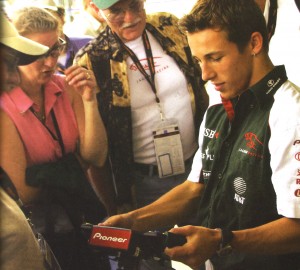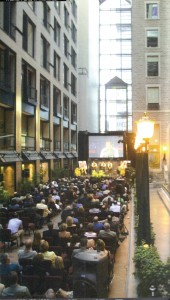By S. Clayton Moore

Red Bull team driver Christian Klien explains the F1 steering wheel set up to a Grand Prix Tours group. The Austrian came up through the Formula Three circuit to become one of the hottest young drivers in Formula One.
Grand Prix Tours puts race fans in the middle of the action like no other racing tour in the world. For a Formula One or NASCAR fan to get any closer to the action, they’d have to be speeding out of the pit themselves. The Newport Beach, Calif.-based company, headed by entrepreneur Barry Simpson, gives unprecedented access to celebrity drivers, F1 and NASCAR construction facilities, garages, race shops and team parties.
“What really makes this company tick is giving our clients the ability to do things they could never do on their own,” said Simpson, a British citizen who came over from the UK in the early 1960s. “You could never get close to a Formula One driver normally. It’s just not possible. Yet we have these drivers at our cocktail parties. That difference is really why we have been successful.”
Grand Prix Tours has been in operation since 1983, when Simpson first started organizing tours from a ramshackle office inside a girlfriend’s garage in southern California.
“I had borrowed $20,000 to start it up,” Simpson remembered. “It was me and a little Apple computer. When somebody would call, I would start the printer going to make it sound like a business office. It was so hot I had to leave the garage door open, so you just hoped the ice cream guy didn’t come along.”
The company has come a long way since then. Simpson now has a rotating staff of 10 to 15 organizing tours for over 3,000 clients a year. The extravagant experience takes customers to such prestigious races as the American, British and Italian Grand Prix, the Daytona 500, and the 24 Hours of Le Mans. Visitors are put up in some of the world’s best hotels, housed in a 300-foot sailing boat off for the Monaco Grand Prix, and treated to exclusive access to the world’s best drivers.
“I started with Formula One because it has been the love of my life,” Simpson explained. “To a degree, the business was started to support a lifestyle. I’ve been lucky in that I’ve built up this wonderful life where I get to go to the races. At the same time, the business has developed over the years into a great business.”
Tour participants get to visit world-class facilities such as the Masarati Factory in Italy, the F1 Pits in Indianapolis, and the new Las Vegas Motor Speedway. Members of the world’s best racing teams host parties and tour stops. Simpson has arranged for drivers to be interviewed on stage by Matt Bishop, editor-in-chief of F1 Racing magazine, Peter Windsor from the Speed Channel, and James Allen, the lead racing commentator from the UK’s ITV network.

Fernando Alonso, the Spanish driver for Renault’s F1 team, and Bob Varsha, the lead commentator for the Speed Channel, discuss the sport with a Grand Prix Tours audience.
“They are incredibly good interviewers and they get stories that you could not imagine,” Simpson said.
The drivers on Grand Prix Tours bring a completely unique perspective to share with racing fans. Just last year, the companies brought in celebrity drivers like Giancarlo Fisichella, Mark Webber, Jarno Trulli, Fernando Alonso and young guns like Christian Klien.
“A professional race driver earns between $4 and $10 million a year,” Simpson said. “They don’t need the money to come and talk on stage for us, but they do it because they enjoy it. They especially like the feedback they get from Americans who have lots of questions and bring a lot of laughter.”
It all started 20 years ago when Simpson invited Championship F1 driver Jonathan Palmer from the Tyrell Racing Team.
“We were fortunate to bring in Jonathan,” Simpson remembered. “He was an absolutely charismatic speaker. He’d tell you how the car would slide on the track at Monaco and he’d touch the barrier to stop the slide. He talked about the car being upside down in the tunnel at 200 miles an hour and how it would stick to the top of the tunnel because of the down force on the car. He talked about braking at 4G, where a tear would come out of his eye and hit the visor directly in front of him.”
Because of Grand Prix Tours’ close relationship with professionals in the racing industry, they sometimes get to know drivers even before they become superstars.
“We’ve been around a long time and you get to know people,” Simpson said. “We were talking to Christian Klien, the former Jaguar driver, even before he became a Formula One driver. It was obvious that he was very good when he was in Formula Three and the Spoiler Series. We used to pull his leg and say that when he made the Formula One circuit, he had to do all of our talks for free. Of course, now he’s driving for Red Bull as a Formula One driver and he does all sorts of talks for us.”
Another expert with a long track record for Grand Prix Tours is Phil Hill. The champion driver won the endurance race at Le Mans three times in the 1950s before charging up the F1 standings in 1961. Driving for Ferrari, Hill won the Italian Grand Prix to take the title by a point from his teammate Wolfgang von Trips, who was killed in the same event.
“Phil has been doing tours with us for over 15 years,” Simpson said. “He’s the most charming fellow, has an incredible memory and is incredibly knowledgeable. He lived these life-and-death situations on a daily basis. He’s a friend and becomes a friend of everybody on the tour.”
Simpson has also taken care to make sure that his clients get a unified experience from booking their tour right through race day.
“When we hire somebody, they’re not just somebody to answer the phone,” Simpson explained. “They learn the entire business right from the get-go. They do a lot of research into the trips so they’re able to answer any questions that come up. They write the brochure, put it on the Web, speak to the customer and meet the customer on the tour. You’re never dealing with an outside element.”
Although he’s as thrilled with race day as his clients, Simpson is also fascinated with the business aspect of the sport.
“The business is fascinating,” he said. “Some of these teams have 900 employees and spend $300 million so they can field three cars for 18 races on the track. The sums are staggering. If the marketing people can bring the money in, the engineers get to spend it making cars go faster and faster. That technology slowly comes into other forms of transportation and helps save lives, so there are a lot of good things that come out of racing.”

Drivers in the Canadian Grand Prix discuss the race with tour participants during a themed party at the Intercontinental Hotel.
Grand Prix Tours is still going full speed ahead. Its partners include former Major League Baseball Commissioner Peter Uberoth, who tried unsuccessfully to buy the company.
“The thought of retiring is never on my mind,” Simpson said. “Because our customers enjoy this experience so much, they stay with us for many years. There are probably about 50 companies doing race tours out there, but most of them are just moving as many people as possible to a race as cheaply as possible. I can’t say that we’re the cheapest company, but we don’t cut corners. There’s no other company getting as close to drivers as we are. We’ll put you places you can’t go otherwise.”
For more information, visit [http://www.gptours.com/].











